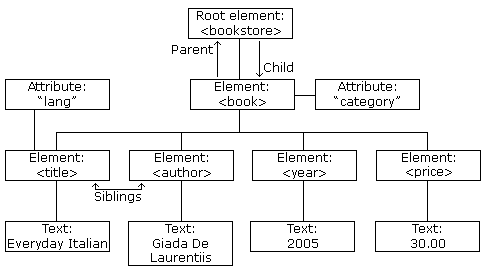 XML Tree
XML Tree
XML documents form a tree structure that starts at "the root" and branches to "the leaves".
XML Tree Structure

An Example XML Document
The image above represents books in this XML:<?xml version="1.0" encoding="UTF-8"?>
<bookstore>
<book category="cooking">
<title lang="en">Everyday Italian</title>
<author>Giada De Laurentiis</author>
<year>2005</year>
<price>30.00</price>
</book>
<book category="children">
<title lang="en">Harry Potter</title>
<author>J K. Rowling</author>
<year>2005</year>
<price>29.99</price>
</book>
<book category="web">
<title lang="en">Learning XML</title>
<author>Erik T. Ray</author>
<year>2003</year>
<price>39.95</price>
</book>
</bookstore> XML Tree Structure
XML documents are formed as element trees.An XML tree starts at a root element and branches from the root to child elements.
All elements can have sub elements (child elements):
<root>
<child>
<subchild>.....</subchild>
</child>
</root> Parent have children. Children have parents. Siblings are children on the same level (brothers and sisters).
All elements can have text content (Harry Potter) and attributes (category="cooking").
Self-Describing Syntax
XML uses a much self-describing syntax.A prolog defines the XML version and the character encoding:
<?xml version="1.0" encoding="UTF-8"?> <bookstore> <book category="cooking"> <title lang="en">Everyday Italian</title>
<author>Giada De Laurentiis</author>
<year>2005</year>
<price>30.00</price> </book> 